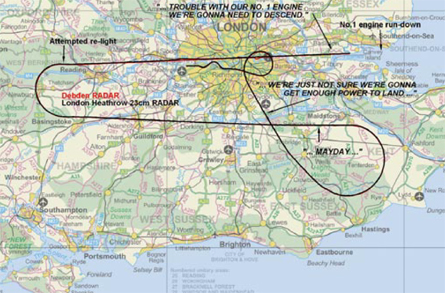The UK Civil Aviation Authority (CAA) is urged to revise its emergency diversion guidelines in a report into an incident in which a Boeing 747 with engine problems flew over central London in April 2004.
The UK Air Accident Investigation Branch (AAIB) bulletin released today into the incident involving a 747-100F operated by Evergreen International Airlines (N481EV), which circled above urban areas while on a divert to London Heathrow airport, highlights several "shortcomings" in the CAA's guidance onemergency diversion incidents.
On 24 April 2004 the aircraft was carrying out a flight from the US Air Force base in

The AAIB bulletin recommends that the CAA examine “whether sufficient guidance is provided on the avoidance of built-up areas when vectoring aircraft in emergency”, and suggests that if a study indicates procedural shortcomings, “this guidance should be amended as soon as practicable”. The CAA says that it is still studying the report, but expects to respond to the recommendations “within weeks”.
UK National Air Traffic Services (NATS) says that its controllers handled the diversion correctly according to existing guidelines, which in an emergency require that air traffic control "accommodate the pilot’s request for diversion to a particular airport provided the airport accepts the diversion, and provided the flight is neither military nor carrying dangerous cargo". In the latter cases aircraft would be diverted to airports that are not close to a conurbation, says NATS.
The report acknowledges that air traffic control handled the diversion correctly according to existing manuals, and adds: “The investigation team recognised both the professionalism demonstrated by the NATS personnel and the skill of the crew of N481EV, in particular the commander’s hand flying of the aircraft, all of which contributed to a safe landing under such difficult circumstances.”
It adds: “No reasons were found which could account for the apparent run-down of No. 1 engine or the crew’s subsequent perception that the remaining three engines were not delivering the selected thrust”, says the AAIB.
DAVID LEARMOUNT / LONDON
Source: Flight International























